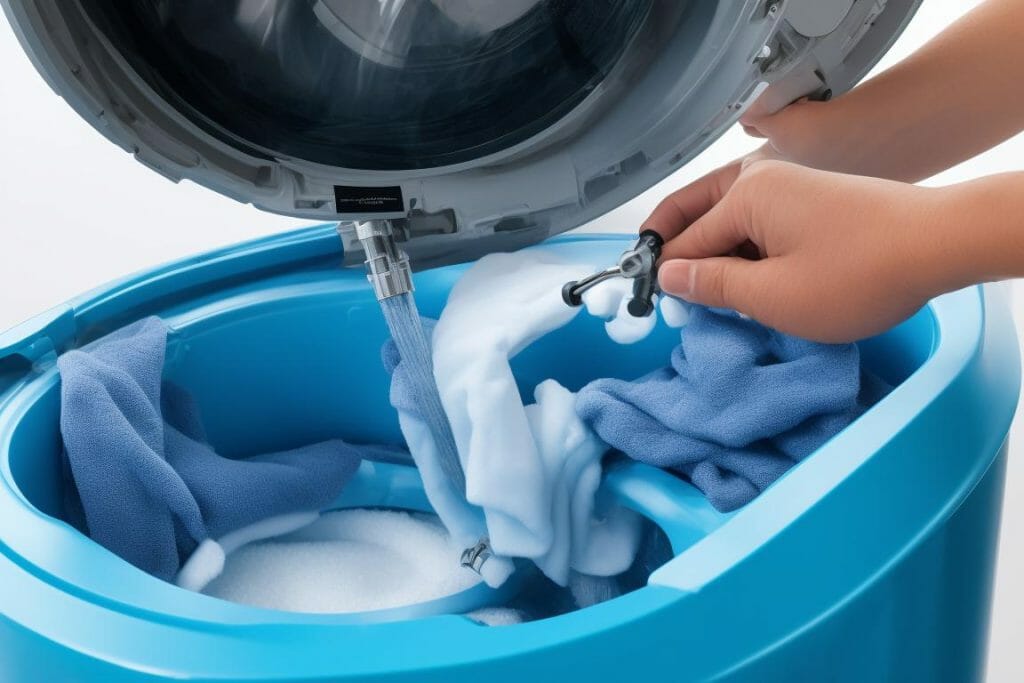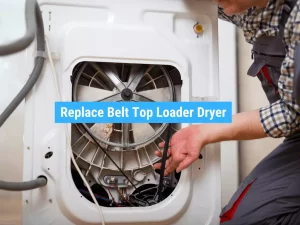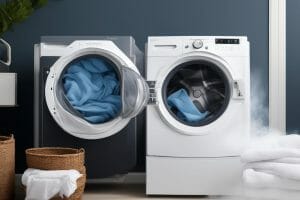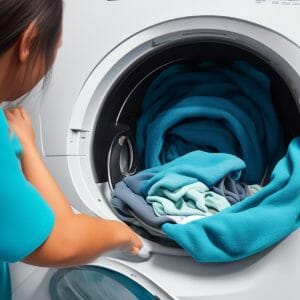Step-by-Step Guide to Installing a Top Loader Dryer
Are you ready to take on the challenge of installing a top loader dryer? Like a handy DIY expert, you can transform your laundry area into a functional and efficient space.
In this step-by-step guide, we will walk you through the entire installation process, from gathering the necessary tools to troubleshooting any issues that may arise.
By the end, you’ll have a perfectly installed dryer that will make laundry day a breeze.
Let’s get started and make your laundry room feel like your own personal sanctuary.
Key Takeaways
Safety Precautions
Before you begin installing the top loader dryer, make sure to take all necessary safety precautions.
Installing a dryer may seem simple, but it is important to prioritize your safety.
First, ensure that the power is turned off to prevent any electrical accidents.
Additionally, make sure to wear appropriate protective gear, such as gloves and safety glasses, to avoid any injuries.
It is also crucial to carefully read and follow the manufacturer’s instructions for installation.
This will help you avoid common installation mistakes that can lead to potential hazards.
Some common mistakes include improper venting, incorrect electrical connections, and improper leveling of the dryer.
Gathering the Necessary Tools and Materials
To get started with the installation of your new top loader dryer, you’ll need to gather a few tools and materials. Tool selection is crucial to ensure a smooth and efficient installation process.
First, grab a screwdriver, an adjustable wrench, and a level. These tools will help you securely attach the dryer to the wall and level it properly.
Additionally, you’ll need pliers and wire strippers to connect the electrical wires.
Material sourcing is equally important. Make sure you have a dryer vent hose that is the appropriate size for your dryer and venting needs. It’s also a good idea to have duct tape and clamps to secure the vent hose in place.
Last, check the manufacturer’s instructions for any specific materials they recommend for your particular dryer model.
Preparing the Installation Area
Now that you have all the necessary tools and materials, it’s time to prepare the installation area for your new top loader dryer. Follow these steps to ensure a successful installation:
- Choosing the right location: Look for a well-ventilated area with easy access to an electrical outlet and a water source. Keep in mind that the dryer will need some clearance space around it for proper airflow.
- Measuring the space: Before installing your dryer, measure the available space to ensure a proper fit. Take into account the dimensions of the dryer, as well as any additional space needed for door clearance and venting.
- Clearing the area: Remove any obstacles or clutter from the installation area. Make sure there is enough space for the dryer to be easily maneuvered into position.
- Preparing the floor: Ensure that the floor is level and sturdy enough to support the weight of the dryer. If necessary, use a leveling tool to adjust the floor before installation.
Connecting the Ventilation System
Once you’ve chosen the right location, it’s important to connect the ventilation system for your new top loader dryer. Proper ventilation is crucial for the efficient and safe operation of your dryer.
There are different venting options to consider, such as rear venting or side venting, depending on the layout of your laundry room. Rear venting is the most common option and requires a straight path from the back of the dryer to the outside.
Side venting is an alternative when rear venting is not possible. It allows the dryer to be placed closer to the wall, but it may require additional parts and professional installation.
It’s important to follow the manufacturer’s instructions and consult a professional if you’re unsure about the venting requirements for your specific model.
Installing and Leveling the Dryer
When it comes to installing and leveling your dryer, it’s important to use proper techniques to ensure optimal performance and longevity.
Proper installation not only prevents potential damage to your dryer but also ensures that it operates efficiently, which can save you time and money in the long run.
Dryer Leveling Techniques

To ensure proper functioning, start by checking if your dryer is level. Dryer stability is essential for efficient operation and reducing noise. Here are some techniques to help you achieve a stable dryer:
Importance of Proper Installation
Make sure you understand the importance of proper installation for your dryer.
Proper installation ensures that your dryer operates efficiently and safely. It also helps to extend the lifespan of your appliance and reduces the risk of costly repairs in the future.
Maintenance is key to ensuring your dryer continues to function optimally. Regular cleaning of the lint filter and exhaust vent is essential to prevent lint buildup, which can lead to decreased efficiency and even fire hazards.
Professional installation services can provide peace of mind, as they have the expertise to correctly install your dryer, ensuring that it is properly vented and connected to the electrical supply.
Investing in professional installation is a worthwhile decision that will benefit you in the long run.
Connecting the Power Supply
When it comes to connecting the power supply for your dryer, there are a few key points to keep in mind.
First, make sure you are familiar with the electrical wiring requirements for your specific dryer model. This will ensure that you have the correct voltage and amperage for a safe and efficient connection.
Additionally, it is important to follow safety precautions when connecting the power supply, such as turning off the electricity at the breaker and using proper insulation and grounding techniques.
Lastly, if you encounter any issues with the power supply, troubleshooting can help identify and resolve the problem, whether it’s a faulty outlet or a wiring issue.
Electrical Wiring Requirements
The first step in installing a top loader dryer is ensuring that the electrical wiring meets the necessary requirements. Proper installation of electrical wiring is crucial for the safe and efficient operation of your dryer. Here are some key points to consider:
Safety Precautions When Connecting
Ensure that you hire a licensed electrician to safely and correctly connect the electrical wiring for your top loader dryer. This is crucial for avoiding accidents and preventing electrical hazards. Electrical work can be dangerous, and it’s important to prioritize safety. By hiring a professional, you can have peace of mind knowing that the wiring is done correctly and up to code.
To further emphasize the importance of safety, here is a table highlighting some common electrical hazards and the steps you can take to prevent them:
| Electrical Hazard | Prevention Tips |
|---|---|
| Electric shock | Ensure proper grounding |
| Overheating | Regularly clean and maintain |
| Short circuit | Use surge protectors |
Following these tips and hiring a licensed electrician will help ensure that your top loader dryer is safely connected, minimizing the risk of accidents and electrical hazards.
Troubleshooting Power Supply
Hiring a licensed electrician ensures safe and correct electrical wiring connections for your top loader dryer. However, in case you encounter any power supply issues, here are some troubleshooting steps you can take:
- Check the power outlet: Ensure that the power outlet you are using is functioning properly. Try plugging in another device to see if it works.
- Inspect the circuit breaker: Locate the circuit breaker panel in your home and check if any breakers have tripped. Reset any tripped breakers by flipping them back to the ‘on’ position.
- Test the voltage: Use a voltage tester to check if the power outlet is delivering the correct voltage. If it is not, you may need to call an electrician to address the issue.
- Consider a dedicated circuit: If your dryer is consistently tripping the circuit breaker, it may be drawing too much power. Installing a dedicated circuit for your dryer can help prevent this issue.
Testing and Troubleshooting

First, check if your dryer is receiving power by making sure it is plugged in and the circuit breaker is not tripped.
Maintaining your dryer is essential to ensure its optimal performance and longevity. Regular maintenance can prevent common dryer problems and save you from costly repairs. To keep your dryer running smoothly, clean the lint trap after every use and periodically check the vent for any clogs or obstructions.
Additionally, inspect the dryer drum for signs of wear and tear, such as cracks or loose seals. If your dryer is not heating properly, it could indicate a faulty heating element or thermostat, which may require professional assistance.
Frequently Asked Questions
How Do I Clean the Lint Trap in My Dryer?
To clean the lint trap in your dryer, you should do it regularly, depending on its cleaning frequency. Use lint removal techniques such as vacuuming or using a lint brush.
Can I Stack My Top Loader Dryer on Top of My Washing Machine?
Sure, you can stack your top loader dryer on top of your washing machine. It’s a popular option for saving space in small laundry rooms. Another alternative is placing the dryer next to the washing machine.
What Is the Recommended Clearance Space Around the Dryer for Proper Ventilation?
To ensure proper ventilation and prevent overheating, it is important to maintain a recommended clearance space around your dryer. This allows for adequate airflow, reducing the risk of fire and improving the dryer’s efficiency.
Can I Use a Flexible Duct for the Ventilation System Instead of a Rigid One?
You should use a rigid duct for the ventilation system instead of a flexible duct. Although flexible ducts offer some flexibility, rigid ducts provide better airflow and reduce the risk of lint buildup.
How Often Should I Clean the Dryer Vent to Prevent a Fire Hazard?
To keep your home safe from fire hazards, it’s important to clean your dryer vent regularly. Aim for at least once a year, but if you notice reduced airflow or longer drying times, clean it more often. Also, ensure proper ventilation clearance space for optimal safety.
Conclusion
Congratulations! You’ve successfully installed your top loader dryer.
Now, picture this: as you stand back and admire your newly installed appliance, you can almost hear the soothing hum of the dryer as it effortlessly dries your clothes, like a gentle breeze on a warm summer day.
With your expert installation, you can trust that your dryer will provide efficient and reliable performance for years to come.
So sit back, relax, and enjoy the convenience and comfort that your top loader dryer brings to your home.







